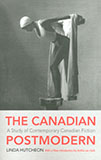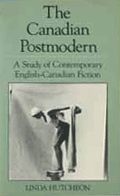The Canadian Postmodern:
A Study of Contemporary English-Canadian Fiction
What is the “Canadian postmodern”? Nigel Scott’s cover photograph offers a place to start:
this is self-consciously art (note the unevenly hung backdrop) and it is obviously parodic,
exploiting but also carefully undermining several recognizable traditions of the representation
of women (passive woman on pedestal; pin-up bathing beauty; Rolls Royce figure) in order to
show how art constructs rather than reflects ‘reality’. In the postmodern novel, we find the
same self-reflexivity, the same parody, but always combined with an awareness of the
particularities of the place and time in which the work is both written and read. The move from
modernism to postmodernism came with the paradoxical use of that art-as-art focus to engage directly
with the social, the political, and the historical—to comment critically on the worlds of both art and experience.
The Canadian Postmodern examines the theory and practice of postmodernism as seen through both
contemporary cultural theory and the writings of Audrey Thomas, Michael Ondaatje, Robert Kroetsch,
Margaret Atwood, Timothy Findley, Jack Hodgins, Aritha Van Herk, Leonard Cohen, Susan Swan, Clark
Blaise, George Bowering, and others.
Table of Contents
Preface
Chapter One:
Introduction
Chapter Two:
Caveat Lector: The Early Postmodernism of Leonard Cohen
Chapter Three:
The Postmodernism Scribe: The Dynamic Stasis of Contemporary Canadian Writing
Chapter Four:
Historiographic Metafiction
Chapter Five:
The Postmodern Challenge to Boundaries
Chapter Six:
‘Shape Shifters': Canadian Women Writers and the Tradition
Chapter Seven:
Process, Produce, and Politics: The Postmodernism of Margaret Atwood
Chapter Eight:
Seeing Double: Concluding with Kroetsch
Appendix:
The Novel (1972-1984) from
The Literary History of Canada, Vol. 4.

